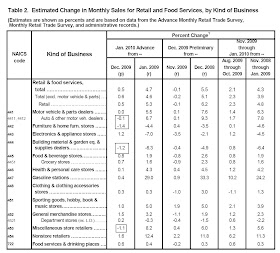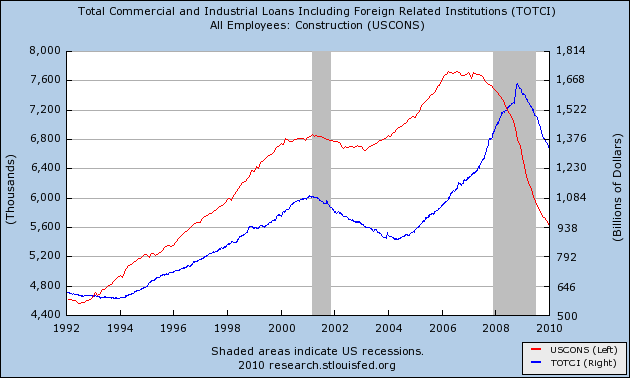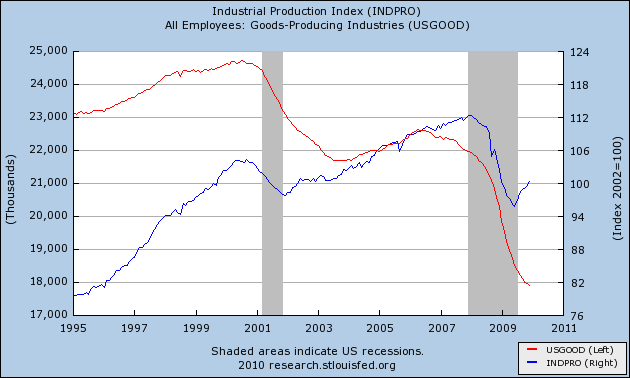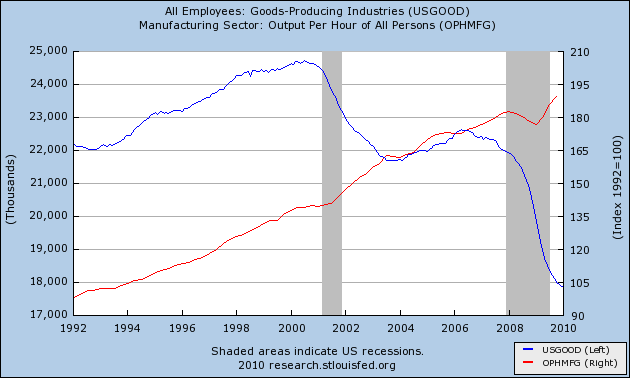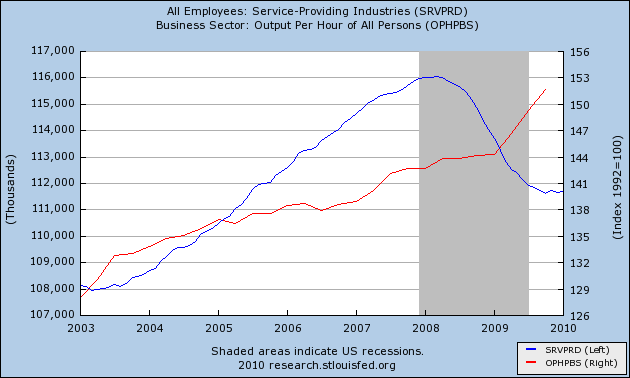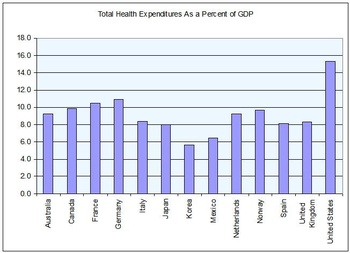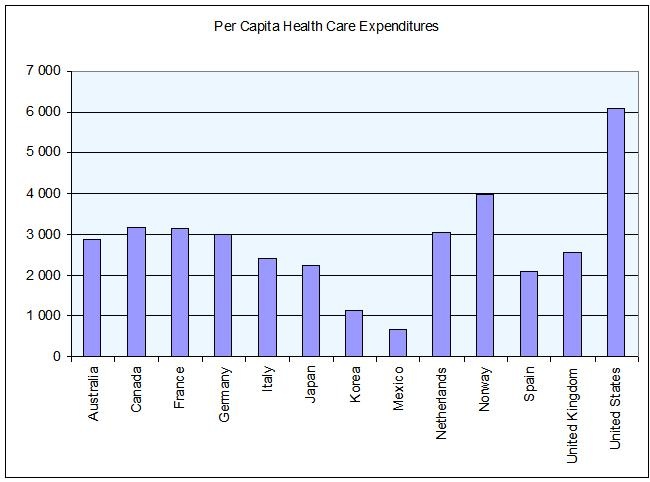Earlier this week,
Chairman Bernanke gave a policy update. This also provides a good overview of what the Fed has done to stabilize the economy.
With the onset of the crisis in the late summer and fall of 2007, the Federal Reserve aimed to ensure that sound financial institutions had sufficient access to short-term credit to remain sufficiently liquid and able to lend to creditworthy customers, even as private sources of liquidity began to dry up. To improve the access of banks to backup liquidity, the Federal Reserve reduced the spread over the target federal funds rate of the discount rate--the rate at which the Fed lends to depository institutions through its discount window--from 100 basis points to 25 basis points, and extended the maximum maturity of discount window loans, which had generally been limited to overnight, to 90 days. Many banks, however, were evidently concerned that if they borrowed from the discount window, and that fact somehow became known to market participants, they would be perceived as weak and, consequently, might come under further pressure from creditors. To address this so-called stigma problem, the Federal Reserve created a new discount window program, the Term Auction Facility (TAF). Under the TAF, the Federal Reserve has regularly auctioned large blocks of credit to depository institutions. For various reasons, including the competitive format of the auctions, the TAF has not suffered the stigma of conventional discount window lending and has proved effective for injecting liquidity into the financial system.
First, the Fed acted in its traditional role by lowering the discount rate. This is the rate the Federal Reserve charges banks that borrow temporary loans. However, at the height of the crisis (and even today) banks were concerned about the impression this borrowing could make. If a bank goes to the Federal Reserve to borrow money and word got out, it is likely the public would view the borrowing negatively. Consider this: you hear that your bank is borrowing money from the Federal Reserve. Is that a good or a bad development? For most people, that is a bad development. In other words, borrowing from the Fed could lead to a bank run, thereby hurting the bank borrowing the funds. As a result, the Fed started a new program that was very successful in providing short-term liquidity to the market.
Liquidity pressures in financial markets were not limited to the United States, and intense strains in the global dollar funding markets began to spill over to U.S. markets. In response, the Federal Reserve entered into temporary currency swap agreements with major foreign central banks. Under these agreements, the Federal Reserve provided dollars to foreign central banks in exchange for an equally valued quantity of foreign currency; the foreign central banks, in turn, lent the dollars to banks in their own jurisdictions. The swaps helped reduce stresses in global dollar funding markets, which in turn helped to stabilize U.S. markets. Importantly, the swaps were structured so that the Federal Reserve bore no foreign exchange risk or credit risk.
These are the currency swap agreements that Representative Grayson went crazy over, thereby proving he knew nothing about central banking. Here's what a currency swap program is: the US Federal Reserve "swaps" and equal amount of dollars for foreign currency. For example, the Fed sends $100 dollars to the European Central Bank for an equal amount of euros. The Fed holds the euros and the European Central banks puts the dollars out into the European markets. Also note this key phrase:
"the swaps were structured so that the Federal Reserve bore no foreign exchange risk or credit risk." So -- we weren't going to make any money, but we weren't going to lose any money.
As the financial crisis spread, the continuing pullback of private funding contributed to the illiquid and even chaotic conditions in financial markets and prompted runs on various types of financial institutions, including primary dealers and money market mutual funds.4 To arrest these runs and help stabilize the broader financial system, the Federal Reserve used its emergency lending authority under Section 13(3) of the Federal Reserve Act--an authority not used since the Great Depression--to provide short-term backup funding to certain nondepository institutions through a number of temporary facilities.5 For example, in March 2008 the Federal Reserve created the Primary Dealer Credit Facility, which lent to primary dealers on an overnight, overcollateralized basis. Subsequently, the Federal Reserve created facilities that proved effective in helping to stabilize other key institutions and markets, including money market mutual funds, the commercial paper market, and the asset-backed securities market.
First, note the Fed acted within the bounds of the law. This was not an illegal takeover of the financial system orchestrated by the Illuminati with the help of the Masons. It was the central bank of the US using its specifically enumerated powers to stabilized a very nervous and ill-performing financial system. Also note: the loans were overcollateralized -- the Fed required the borrowers to provide excess "stuff" to make sure the loan was repaid.
And guess what?
As was intended, use of many of the Federal Reserve's lending facilities has declined sharply as financial conditions have improved.6 Some facilities were closed over the course of 2009, and most other facilities expired at the beginning of this month. As of today, the only facilities still in operation that offer credit to multiple institutions, other than the regular discount window, are the TAF (the auction facility for depository institutions) and the Term Asset-Backed Securities Loan Facility (TALF), which has supported the market for asset-backed securities, such as those that are backed by auto loans, credit card loans, small business loans, and student loans. These two facilities will also be phased out soon: The Federal Reserve has announced that the final TAF auction will be conducted on March 8, and the TALF is scheduled to close on March 31 for loans backed by all types of collateral except newly issued commercial mortgage-backed securities (CMBS) and on June 30 for loans backed by newly issued CMBS.7
.....
In summary, to help stabilize financial markets and to mitigate the effects of the crisis on the economy, the Federal Reserve established a number of temporary lending programs. Under nearly all of the programs, only short-term credit, with maturities of 90 days or less, was extended, and under all of the programs credit was overcollateralized or otherwise secured as required by law. The Federal Reserve believes that these programs were effective in supporting the functioning of financial markets and in helping to promote a resumption of economic growth. The Federal Reserve has borne no loss on these operations thus far and anticipates no loss in the future. The exit from these programs is substantially complete: Total credit outstanding under all programs, including the regular discount window, has fallen sharply from a peak of $1-1/2 trillion around year-end 2008 to about $110 billion last week.
We're almost done! There are only two facilities still in operation. Think about that for a moment -- despite all of the hyper-ventilating about the Federal Reserve over the last few months, the Fed has quietly stopped most of its lending facilities. Imagine that.
Let's continue an analysis of what Bernanke said.
In addition to supporting the functioning of financial markets, the Federal Reserve also applied an extraordinary degree of monetary policy stimulus to help counter the adverse effects of the financial crisis on the economy. In September 2007, the Federal Reserve began reducing its target for the federal funds rate from an initial level of 5-1/4 percent. By late 2008, this target reached a range of 0 to 1/4 percent, essentially the lowest feasible level. With its conventional policy arsenal exhausted and the economy remaining under severe stress, the Federal Reserve decided to provide additional stimulus through large-scale purchases of federal agency debt and mortgage-backed securities (MBS) that are fully guaranteed by federal agencies. In March 2009, the Federal Reserve expanded its purchases of agency securities and began to purchase longer-term Treasury securities as well. All told, the Federal Reserve purchased $300 billion of Treasury securities and currently anticipates concluding purchases of $1.25 trillion of agency MBS and about $175 billion of agency debt securities at the end of March. The Federal Reserve's purchases have had the effect of leaving the banking system in a highly liquid condition, with U.S. banks now holding more than $1.1 trillion of reserves with Federal Reserve Banks. A range of evidence suggests that these purchases and the associated creation of bank reserves have helped improve conditions in private credit markets and put downward pressure on longer-term private borrowing rates and spreads.
First, the Fed lowered interest rates to essentially 0% -- about as low as they can go. This is the standard policy response to an economic crisis. While it does run the risk of creating an asset bubble it also helps to encourage people to borrow. In addition, a low short-term rate helps financial institutions bottom line. Remember that banks borrow short (taking in deposits) and lend long (making loans). The difference they make (also called the spread) goes to the banks bottom line.
Next, the Fed started to buy bonds. They did this to provide liquidity to the market. Anytime you hear someone say "there is no liquidity" it simply means they can't sell a particular asset. At the height of the crisis, no one was buying anything. When this happens, interest rates on bonds increase to attract buyers. This would be detrimental to an economy that isn't producing any credit. To combat this situation (and keep interest rates low), the Federal Reserve bought Treasury, agency and MBS (mortgage backed bonds).
So, how will the Federal Reserve Exit this program?
Most importantly, in October 2008 the Congress gave the Federal Reserve statutory authority to pay interest on banks' holdings of reserve balances. By increasing the interest rate on reserves, the Federal Reserve will be able to put significant upward pressure on all short-term interest rates, as banks will not supply short-term funds to the money markets at rates significantly below what they can earn by holding reserves at the Federal Reserve Banks. Actual and prospective increases in short-term interest rates will be reflected in turn in longer-term interest rates and in financial conditions more generally
Each bank that is a member of the Federal Reserve system (which is practically every bank in the US) has deposits with their respective Federal Reserve Bank. Now the Fed can pay interest on these loans. Banks won't make loans to customers at rates below the rate the Fed is paying -- that just wouldn't make any sense. So this will one tool the Fed will use to increase interest rates when the time is right.
The Federal Reserve has also been developing a number of additional tools it will be able to use to reduce the large quantity of reserves held by the banking system. Reducing the quantity of reserves will lower the net supply of funds to the money markets, which will improve the Federal Reserve's control of financial conditions by leading to a tighter relationship between the interest rate on reserves and other short-term interest rates.
One such tool is reverse repurchase agreements (reverse repos), a method that the Federal Reserve has used historically as a means of absorbing reserves from the banking system. In a reverse repo, the Federal Reserve sells a security to a counterparty with an agreement to repurchase the security at some date in the future. The counterparty's payment to the Federal Reserve has the effect of draining an equal quantity of reserves from the banking system. Recently, by developing the capacity to conduct such transactions in the triparty repo market, the Federal Reserve has enhanced its ability to use reverse repos to absorb very large quantities of reserves. The capability to carry out these transactions with primary dealers, using our holdings of Treasury and agency debt securities, has already been tested and is currently available. To further increase its capacity to drain reserves through reverse repos, the Federal Reserve is also in the process of expanding the set of counterparties with which it can transact and developing the infrastructure necessary to use its MBS holdings as collateral in these transactions.
This is central banking 101. Right now, banks have a ton of liquidity -- meaning they have a lot of cash on hand. To drain liquidity -- to lower the amount of cash on each bank's balance sheet -- the Fed will essentially swap an asset (a bond) for cash. This lowers the amount of liquidity in the system. Less liquidity = higher interest rates.
As a second means of draining reserves, the Federal Reserve is also developing plans to offer to depository institutions term deposits, which are roughly analogous to certificates of deposit that the institutions offer to their customers. The Federal Reserve would likely auction large blocks of such deposits, thus converting a portion of depository institutions' reserve balances into deposits that could not be used to meet their very short-term liquidity needs and could not be counted as reserves. A proposal describing a term deposit facility was recently published in the Federal Register, and we are currently analyzing the public comments that have been received. After a revised proposal is reviewed by the Board, we expect to be able to conduct test transactions this spring and to have the facility available if necessary shortly thereafter. Reverse repos and the deposit facility would together allow the Federal Reserve to drain hundreds of billions of dollars of reserves from the banking system quite quickly, should it choose to do so.
In essence, banks would now be able to open an account with the Federal Reserve and earn interest on the deposit. This would also drain liquidity from the system.
This was a really good speech for highlighting exactly what the Fed has done and what it's plans are. It should provide the market a great deal of calm.

